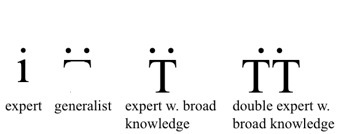Co-written by Riddhi Shah
Experts and generalists are less than useful, however those who thoroughly master a discipline while having a broad general knowledge of multiple disciplines, also called T-shaped people were, at one time, worth their weight in gold.
Now, once again, more multi-disciplinary designers are becoming indispensable for creating breakthrough innovations. These so-called, "TT-shaped people" are the professionals who master two or more distinct and complementary skills and can bridge domains without falling into the trap of providing a solution catering to the lowest common denominator.
In the hustle and bustle of the design-world, continued development of one's professional capabilities demands a deliberate concerted effort. In the studio, designers can hone their design skills on the clients' dime. However, if designers want to add a new and established professionalism to their quiver, winging it while on the job only protracts the process.
Never fully acquiring the fundamentals of a mature second discipline often leads to a dilution of one's professional profile, which can seriously damage one's reputation. Therefore, the best approach may be to bite the bullet and make the investment in a Masters or a PhD.
Across the world, universities are beginning to offer designers capstone business educations that are relevant to their field. At institutions such as Hong Kong Polytechnic University, Hanyang University in South Korea and Art Center College of Design, Pasadena, California, designers now have the opportunity to build capabilities in innovation management in accelerated programs. One of the critical skills taught is how to successfully bridge business and design.
The logistics of juggling a fulltime position and studying at night and on weekends or taking a sabbatical from work life turns out to be the easy part. The challenge for professional designers is often the emotional toll of going back to school again to build new competencies from the ground up.
Some of the more positive insights garnered from designers around the world who took on this challenge, included:
"Participating in a workshop on Bridging Business & Design" was truly an exercise in brainstorming, forcing our left and right brains to work in harmony. It provided food for thought on how one might apply analytical (SWOT, Porters 5 Forces and business model canvas), as well as, creative methods (brainstorming, sketching and intuition). This helped us intuitively understand the linkage between drivers and enablers, paving the way for our creative brief."
"Conducting crowdsourcing and using online social networks to obtain feedback on our business concepts, added a new and very interesting dimension to check the pulse of our audience. It sometimes could be an absolutely unexpected trigger to help spark our creativity and, other times, to sense the general acceptance of our concepts. Focusing on the value proposition, as opposed to flash, we ended up with a final outcome constituting a sound value proposition."
"Overall, the exercise demonstrates oodles of creative potential in building business strategies and hence a strong need for creative professionals to bridge this gap."
Negatives included:
"Too much reading required and course is too difficult to understand and use."
"Not enough time to do all the homework. Work life makes it nearly impossible for our group to meet and some members do not contribute their fair share."
"Don't get enough sleep, am constantly tired and find it challenging to juggle deliverables for so many courses."
Becoming a professional, proficient "TT-shaped" person and cross-pollinating any field is a challenge for everyone involved, including significant others, employers and, of course, the daring individual who makes the investment. The upside is that it is a competitive advantage in the job market and one that is difficult for others to copy. It has also been suggested that it increases one's potential for developing truly breakthrough innovations, as opposed to just doing more of the same and the same and the same . . .
Special thanks to Riddhi Shah for researching and co-writing this article.
